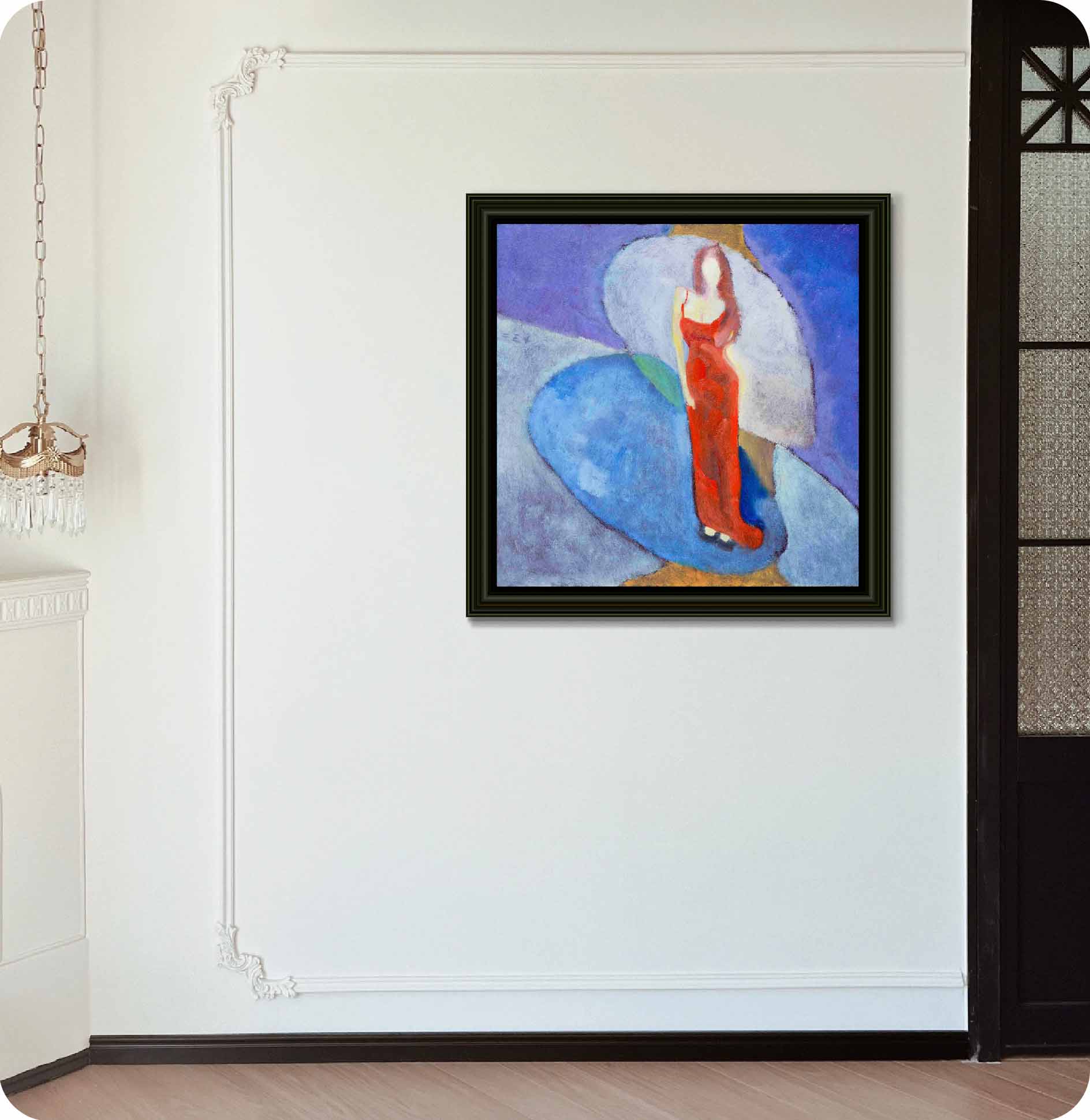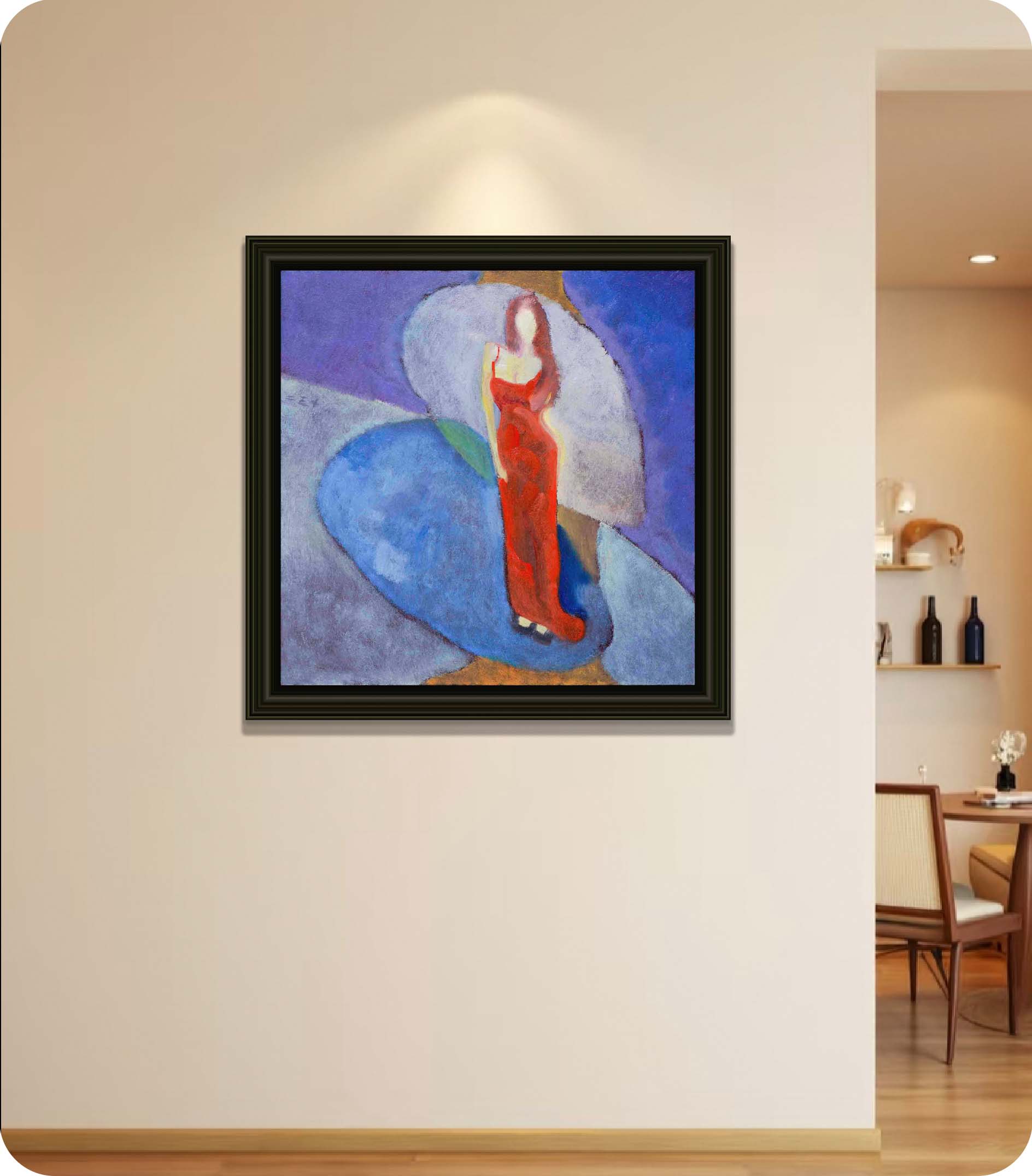The theme of this year's painting clearly states one - the makeup of desire. People's various desires are wrapped under various makeups. Desires are the intertwining of happiness and pain in life. Either straightforward or subtle, they will appear in makeup, forming a profound look of an era.
Inches: 15.7 x 15.7 in
Size without the frame: 40 x 40 cm
Country: China
Date: 2025
Materials: Oil paint on wood
Condition: well preserved
Creative themes and style | My works revolve around the creative concept of "The land of humanity, and the people upon it" . The people in the painting are people in nature, and the lines, shapes, and colors are close to nature. The nature in the painting is nature in the eyes of humans, existing in interaction with humans.I don’t pursue a series of works with a fixed and continuous style. I hope that the style of the pictures will synchronize with the changes in my life and always remain oscillating. The performance of the work must be in sync with the development of one's own life in order to be Sincere and powerful.Ideas are later.
An Interview with Artist Philo by Artphiloso Gallery
If you would like to collect this artwork or know more about the artist, please contact us.


Subject and Concept: The title “Veiled Perception 3” immediately points to the theme of obscured or veiled perception. Most notably, the figure’s face and hands are left blank. This deliberate omission shifts the focus from personal identity to the dialogue between form, color, and atmosphere. Instead of asking who the figure is, viewers are invited to explore how vision itself can be refracted, blurred, or concealed.
Form and Gesture: The female figure is stretched vertically, her waist and hips forming a graceful S-curve. This elongation emphasizes elegance and rhythm over naturalism, transforming the body into a living column of color. At the feet, the shoes are reduced to small rectangular marks, almost like punctuation, grounding the figure within the composition and preventing her from floating away in the surrounding fields.
Composition and Space: The figure stands among overlapping elliptical and curved shapes that resemble light pools or reflections. This structure resembles a stage lit by spotlights, where overlapping shadows and halos define the sense of depth. Here, negative space is not empty—the surrounding blues and grays actively push the figure forward, as though she were vibrating on the surface of a color field.
Color and Light: The painting thrives on the clash of warm versus cool tones. The crimson-red dress radiates against fields of cobalt blue, violet, and gray-blue. Along the figure’s edges, halos of yellow, orange, and pale green produce an almost electric glow, where warm and cool tones collide. These shimmering borders create a sense of breathing edges, making the body feel both radiant and fragile. Meanwhile, softened grayish blues mute the transitions, ensuring the red remains intense but not overpowering.
Brushwork and Texture: The canvas surface reveals both dry brushing and layered glazing. Large areas are applied with broad, fibrous strokes that give the paint a fabric-like weave. Around the edges, blurred contours produce a lingering afterimage, slowing down the act of seeing. Within the dress, multiple translucent layers build up a pulsing rhythm, as if the red fabric itself were alive.
Content and Theme: At its heart, the work suggests that the body becomes a receptor of light and perception. The blank face signals not absence but anonymity and universality. In this sense, the painting transforms the figure into a vessel of heightened emotion, where presence is expressed precisely through what is withheld.
Mood and Rhythm: The painting navigates between restraint and sensuality. The blue zones feel like mist or water, embodying calmness, while the radiant red introduces passion and intensity. This dynamic creates a push-and-pull of emotional rhythms—serene yet charged, distant yet intimate.
Comparative Perspective: The resonance between color fields and figure recalls Henri Matisse’s flat decorative harmonies and Milton Avery’s simplified human silhouettes. The enveloping glow of the blue fields echoes Mark Rothko’s atmospheric canvases, where colors seem to breathe. The elongated figure, stripped of facial identity, recalls Amedeo Modigliani, though here anonymity is pushed even further. Altogether, this work situates itself between figuration and abstraction, testing how emotion can be seen through color rather than likeness.
Henri Matisse, The Red Room (Harmony in Red): Like Matisse, this work uses large zones of color to dominate spatial structure, demonstrating how color itself can carry narrative weight.
Milton Avery, Coastal Figures Series: Avery’s figures are reduced to pure shapes with calm tonal transitions, echoing this painting’s simplified yet evocative forms.
Mark Rothko, No.61 (Rust and Blue): Rothko’s blurred edges and pulsating color fields resonate with the glowing boundaries seen here.
Amedeo Modigliani’s Portraits: The elongated proportions and faceless anonymity of Modigliani’s figures serve as a parallel for this painting’s rejection of traditional portraiture.
Lin Fengmian, Lady Figures: His work, with its blocky colors, lyrical posture, and deliberate use of blankness, provides an Eastern counterpart to the painting’s poised restraint.
A: The blank face is not a loss but an intentional removal of identity. By doing so, the artist transforms the figure into a universal presence, inviting viewers to project their own emotions onto the canvas. It aligns with the title “Veiled Perception”, where absence itself becomes a medium of perception.
A: These halos are the result of warm and cool tones colliding. Where red meets blue, the edges glow, producing a subtle optical shimmer. The added halos enhance this effect, giving the figure a sense of luminosity and vibration, making the red dress feel alive rather than flat.
A: They can be read as both light pools and reflective surfaces. Much like a stage spotlight, they position the figure in an arena of both visibility and concealment. Here, light and shadow are as active as the body itself, amplifying the theme of being watched and being revealed.
A: This is a piece of contemporary abstract figurative art, blending the color-field style with figuration. It is particularly suitable for minimalist living rooms, boutique hotel lobbies, or brand installations where a balance of calm and intensity is desired. The red-and-blue contrast ensures it becomes a focal point without overwhelming the space, making it ideal for long-term display.
A: Its value lies in its stable color-field structure, the abstracted treatment of the human body, and its resonance with broader academic themes such as the representation of femininity and psychology of color in art. Categorized as a medium-scale original oil on canvas, it belongs to the dialogue of contemporary abstract-figurative works and holds strong potential for integration into curated collections, thematic exhibitions, or series-based acquisitions.
A: Click here to view ARTPHILOSO's Guide for Collectors.
More paintings from this series:
